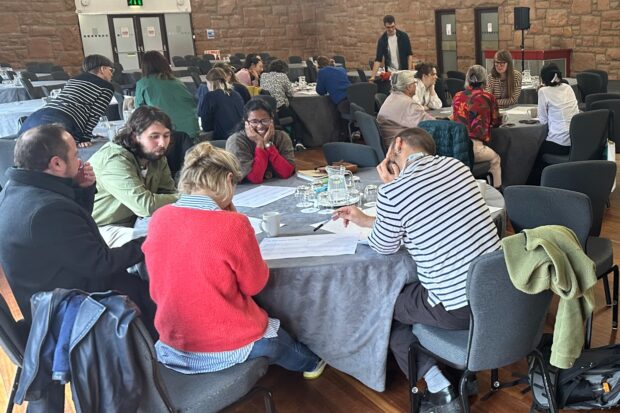
We are challenging ourselves to think about how we might create a vision for a local welfare system that is rooted in Camden Council’s values of empowerment and empathy. A welfare system that starts from how we can give everyone the tools to create a fulfilled and happy life for themselves, rather than focusing on dealing with the symptoms when things go wrong. Building a preventative and strengths-based welfare state is not something you can do overnight — and what that can look like will be a question with lots of answers.
Camden’s leadership believes we have a responsibility to advocate for a future our residents want to see; one which enables people to thrive, tackles poverty, and supports inclusive growth, so we have been asking those “what” and “how” questions. By working with colleagues at UCL’s Institute for Global Prosperity, we have been looking at their model of Universal Basic Services (UBS), what it might look like in a local context, and how it could change local residents’ experience of public services.
Universal basis services for local residents
The premise of UBS is simple. Our welfare state needs to respond to people’s lives, and the opportunities and challenges of our current and future communities. The last widespread welfare reforms happened in the 1940s, and in many important ways we don’t work, relate, travel or look after ourselves in the same ways we did then. We shouldn’t expect a welfare state created for the needs of a different world to produce the best outcomes in our modern context. The hard questions are: what would work for our present world? …and what will continue working for the next generation? …and the one after that?
Our work is looking at these questions in 5 different ways:
- What could a local welfare settlement for the 21st century - founded on the principles of Universal Basic Services - look like?
- How might citizens’ voices shape the design of a new local welfare system?
- Is a new, local, universal welfare system deliverable with the existing capabilities and powers that are available to local authorities?
- What additional capabilities, powers, or resources might be needed to make it deliverable?
- What might the impact of this kind of system be on an individual, a household, or a community?
Policy designers are designing for this third horizon by building a vision for how we might respond to these challenges, and proposing a roadmap for how we get there.

Moving toward the third horizon
The concept of the third horizon comes from Bill Sharpe and the work of the International Futures Forum, and it helps us think through how changes to our status quo happen over time. It moves us from the now (Horizon 1) into our ambitious future vision we want to create (Horizon 3), taking us through the messy transition space (Horizon 2) of how we get there.
It’s a particularly useful framework in work like this, when it feels like the change we might create is too big to grasp, and would involve widespread reform across many parts of our society and a large number of government departments and public institutions. Our work as third horizon policy designers is split into three tasks:
- Defining our vision for the future - This is a lot like defining our missions - it’s about creating a north star of what we are aiming for. At Camden, we believe the most powerful north stars are created by involving a range of perspectives, from our residents to our frontline staff, and we work with both to develop it.
- Understanding the present (and past) - We believe in the power of not reinventing the wheel - and we know that when we’re talking about public sector innovation there is a lot of great work and ideas that we can draw from to learn and build-on. We collaborated with service leaders to understand what’s working well from their perspective, and we had honest conversations with our residents about services they love and sometimes feel frustration.
- Setting the direction of travel - This is perhaps the most traditional design task - looking at the vision we created, and our starting point, then creating a roadmap for how we might move from A to B. This will often be through very small tests and experimentation rather than sweeping changes… but more on this below.
We learnt a lot from working through these tasks with a wide group of stakeholders. Residents’ voices are central to our policy design practice. In a project like this, it’s essential for us that the vision for the future comes from our residents and their experiences. Translating the academic framework of UBS into a set of principles that could guide conversations with local residents enabled us to co-design with them in a meaningful way and discuss concrete ideas.
Eating the elephant
While we gained huge amounts of insight into residents’ lived experiences and hopes for the future, holding these kinds of conversations invites tensions that reflect the fact that the shape and scope of public services can be highly political and can have highly personal consequences. In this context, it is challenging, if not impossible, to separate conversations about the future of public services from conversations about values. Our job, as policy designers, is to create a safe and welcoming environment in which those tensions can be surfaced and resolved in a way that generates insight, connection, and learning rather than discord, frustration, and alienation.
So how might the evidence and insight we have from working in and alongside our communities be used to inform system-level change? How might we effectively engage with actors beyond Camden to build cases for change that would have a positive impact for people in our borough?
Thinking about designing for every policy change we would like to see feels a bit like eating an elephant — it’s too much all at once. It’s the type of task that should be approached systematically, and different parts of it will need different tools and methods.
So our approach categorises issues that are for “now”, i.e. immediate issues that can be addressed in the near future, and issues that are for “next”, i.e. longer-term reform. Issues that are for “now” and “next” can also be categorised as being “active” or “reactive”, depending on whether we are taking the initiative to build something new that we want to see or whether we are acting in response to something. The framework looks something like this:

This framework gives us is a mental model to think about different methods to approach different issues, depending on where they sit in the quadrant. Our work on UBS sits in the top-right corner. The future of the welfare state is a “next” issue, for which we are looking at ideas for long-term reform. This is also an issue that we have chosen to focus on, recognising that it is critically important for our community’s future wellbeing, so it sits in an “active” space.
Our method for this kind of issue is test-bed innovation: exploring how our ideas might work in practice through experimental methods. By starting with small-scale experimentation and gradually scaling up, collecting evidence and insight as we go, our ambition is to generate evidence about impact and deliverability that helps us build an evidence-based vision for the future.
Policy designing the future
Our ambition is that our design practice adds to the conversation about what we want public services to look like in the future, how we should address poverty and inequality, and how we might foster resilient communities that are equipped for the challenges of the 2020s and beyond.
You can read in more depth about our teams’ work in our blog series: The future is now, From theory to practice, and Eating the Elephant.
We’d love to hear from anyone interested in finding out more about the challenges our team is working on and how we might work together. Please comment below if you would like to get in touch.
Join our community
We use this blog to talk about the work of the multidisciplinary policy design community. We share stories about our work, the thinking behind it and what policymaking might look like in the future. If you would like to read more, then please subscribe to this blog. If you work for the UK's government, then you can you join the policy design community. If you don't work for the UK government, then connect with us on social media at Design and Policy Network and subscribe here to be notified about our monthly speaker events to hear from influential design thought leaders and practitioners.